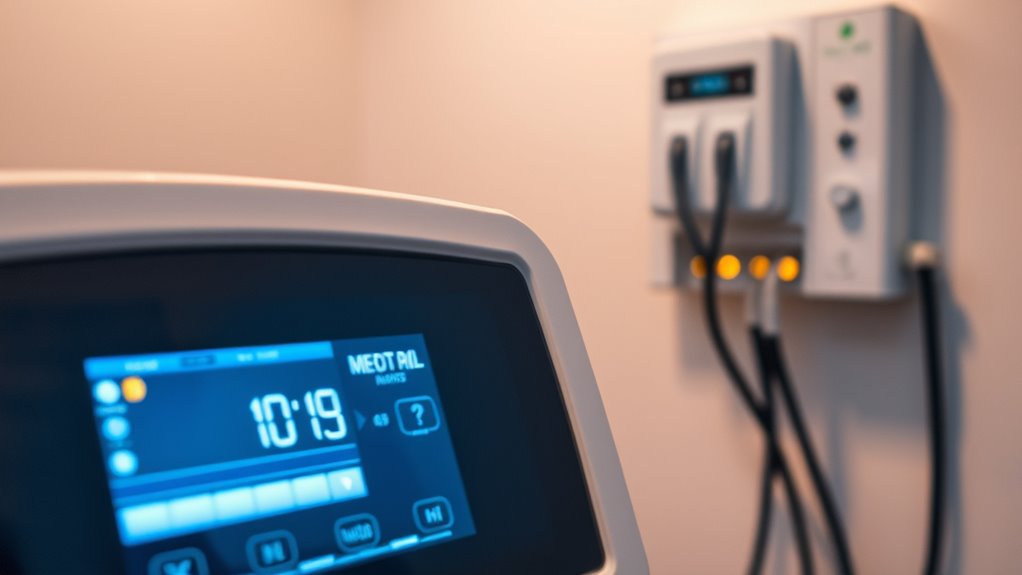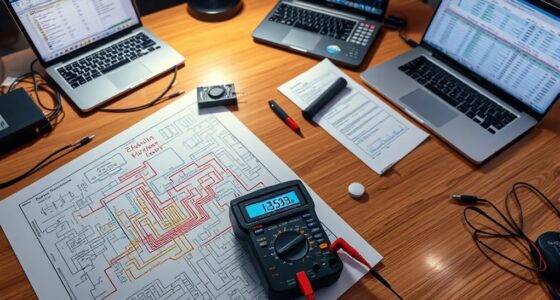To keep critical medical devices powered, guarantee your hospital has reliable backup systems like generators and UPS units that respond within seconds to outages. Regularly test and maintain these systems, keep fuel supplies stocked, and update firmware as needed. Price and space might be concerns, but prioritizing essential equipment with scalable solutions helps. Using advanced monitoring and automation minimizes downtime and ensures patient safety—continue exploring how to optimize your hospital’s power security.
Key Takeaways
- Implement redundant backup power systems like generators and UPS to ensure uninterrupted power during outages.
- Regularly test and maintain backup equipment, including transfer switches and batteries, to verify operational readiness.
- Prioritize critical devices in power load management and use automatic transfer switches for swift power restoration.
- Monitor power quality continuously with real-time diagnostics to detect and address issues proactively.
- Ensure compliance with technical standards and upgrade systems with advanced, reliable power supply technology for optimal safety and performance.
Understanding the Importance of Reliable Power in Healthcare Settings
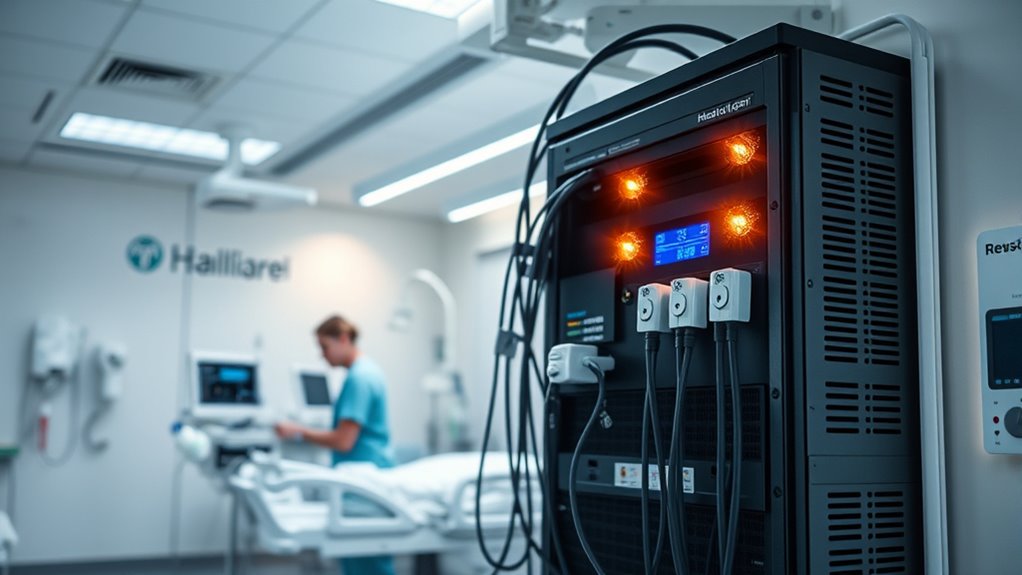
Reliable power is the foundation of safe and effective healthcare delivery. When critical areas like ICUs, surgical theaters, or vaccine storage lose power, patient safety is at immediate risk, and care processes are disrupted. Power outages in healthcare facilities can cost an average of $690,000 per incident, not counting potential legal or life-threatening consequences. Unreliable power undermines hospital resilience and limits adaptive capabilities during emergencies. Many providers manage power reactively, risking patient safety, instead of adopting proactive strategies. Power quality varies daily, with outages and undervoltage lasting hours, even within the same region. Continuous monitoring of power conditions is essential to ensure medical devices function correctly and maintain high standards of care. Power disruptions can also lead to the loss of critical data and compromise cybersecurity, further endangering patient safety. Reliable power truly is the backbone of healthcare operations, and implementing power quality monitoring systems can significantly improve reliability and safety. Regular assessment of power systems and backup power solutions is crucial to prepare for unexpected outages and ensure uninterrupted patient care. Additionally, integrating advanced AI security technologies can enhance the detection of power anomalies and prevent potential cyber threats that could further compromise healthcare infrastructure.
Key Technical Requirements for Hospital Backup Power Systems
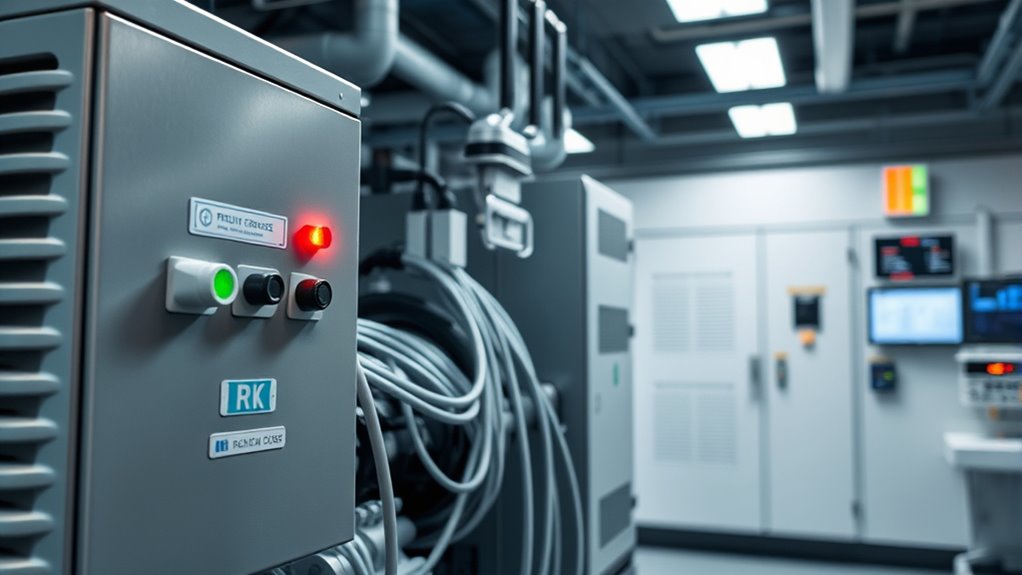
You need backup power systems that respond instantly to outages, restoring critical loads within seconds to guarantee patient safety. Meeting power capacity standards means sizing generators and fuel supplies to handle essential and non-essential loads reliably. Regular system testing confirms that these backups perform as expected when emergencies happen, keeping your hospital prepared at all times. Proper maintenance and staff training are also essential to ensure the continued reliability and safety of the backup power system. Incorporating sound design principles into alarm systems and user interfaces can improve staff response times and reduce errors during emergencies. Additionally, selecting systems with appropriate capacity ensures that all critical equipment remains operational during power disruptions. Ensuring compatibility with power management systems can further optimize hospital operations during outages. Proper system documentation and regular audits also contribute to maintaining system integrity and readiness.
Rapid Response Times
How quickly hospital backup power systems respond during an outage is crucial for patient safety and operational continuity. NFPA 110 mandates that power to life-critical equipment must restore within 10 seconds. Level 1 backup systems supporting vital functions are designed for this rapid response, ensuring immediate power transfer. Systems supporting less critical functions have up to 60 seconds, but critical loads require near-instantaneous activation. To meet these standards, automatic transfer switches (ATS) and uninterruptible power supplies (UPS) are integrated for seamless switching, often achieving transfer times as short as 2–5 seconds. Regular testing, maintenance, and detailed record-keeping ensure these systems perform reliably under pressure. Proper design, fuel management, and robust control systems are essential for maintaining rapid response and preventing delays during outages. Additionally, incorporating system redundancy can further enhance reliability and ensure continuous power supply during unexpected failures.
Power Capacity Standards
Hospitals must guarantee their backup power systems are capable of sustaining critical operations during extended outages. This means ensuring power can last between 24 and 96 hours, with a common standard of 96 hours of fuel on-site. Fuel storage requirements are crucial to prevent refueling issues during prolonged disruptions. NFPA 110 mandates enough fuel to support uninterrupted power for at least 96 hours, depending on location and generator class. Your fuel management plans should consider local risks to avoid power gaps. To strengthen reliability, you might maintain multiple fuel sources, such as diesel and natural gas. Proper capacity planning ensures essential medical devices stay operational without performance loss. Key considerations include:
- Fuel storage capacity for 96 hours
- Multiple fuel sources for redundancy
- Load sizing for full expected demand
- Prioritized power distribution
- Compliance with NFPA 110 standards
- Electric power capabilities are essential to meet these rigorous backup requirements.
System Reliability Testing
Ensuring backup power systems are ready to activate instantly requires rigorous testing and maintenance. You must regularly verify that systems meet activation time standards, which typically range from 10 to 15 seconds, depending on regional regulations. Conduct monthly operational tests simulating power failures to confirm automatic transfer switch and generator response within required timeframes. Annual maintenance by qualified technicians guarantees ongoing reliability and compliance with NFPA 110 standards. Proper documentation of all tests and repairs is essential for regulatory audits and accreditation, such as The Joint Commission and DNV. Additionally, testing helps identify potential issues before actual outages occur. By maintaining strict testing routines, you guarantee that your hospital’s backup power will respond swiftly, safeguarding critical medical devices and patient safety during emergencies. Regular testing schedules should also account for local Ulta Beauty Store Hours and other nearby service providers to ensure maintenance activities do not interfere with hospital operations.
Selecting the Right Uninterruptible Power Supplies (UPS) for Medical Devices
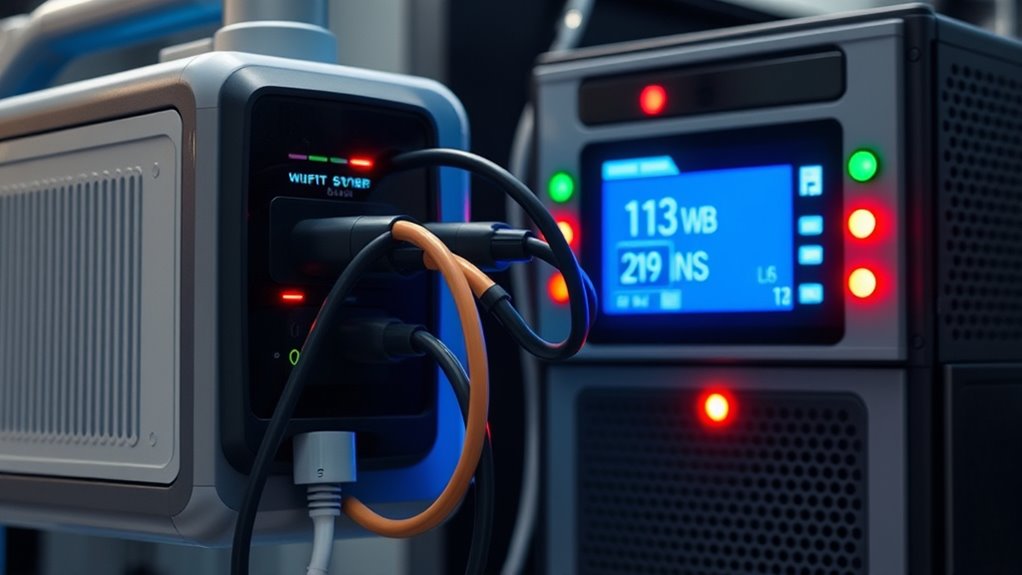
When choosing a UPS for medical devices, you need to consider capacity and runtime options to ensure continuous operation during outages. Compatibility with your equipment is vital to prevent issues like electrical noise or insufficient power delivery. Additionally, regular maintenance and monitoring help keep the UPS reliable and ready when you need it most. Ensuring the UPS has appropriate power capacity can prevent overloads and potential damage to sensitive devices. Understanding the nutritional advantages of green juice can also remind you of the importance of reliable power sources to preserve sensitive medical supplies and devices.
Capacity and Runtime Options
Choosing the right UPS for medical devices requires carefully balancing capacity and runtime to meet your specific clinical needs. You need enough capacity to support your critical equipment during outages and sufficient runtime to ensure safe shutdown or continued operation. Higher battery capacity extends runtime, but load size impacts how long the UPS can sustain devices. Adding extra battery modules can increase runtime without changing capacity. To optimize your setup, consider:
- The total power load of all connected devices
- The required runtime for different outage scenarios
- The efficiency of your UPS system
- Future expansion needs
- Safety margins for inrush currents and peak loads
- Battery management systems play a crucial role in maintaining optimal performance and longevity of your UPS batteries. Additionally, understanding the power capacity of your UPS helps prevent overloads and system failures. Properly monitoring and maintaining battery health ensures reliable operation during critical moments.
Compatibility With Devices
Selecting the right UPS for medical devices requires verifying that the system meets strict safety, EMC, and compatibility standards. Guarantee the UPS provides a clean, pure sine wave output to prevent malfunctions in sensitive equipment like ventilators and monitors. It must deliver stable power free from voltage spikes, sags, and harmonic distortion. Check that the capacity matches your device’s power requirements to avoid overloads. Compatibility details should be clear in the user manual, specifying supported device types. Only use medical-grade UPS units certified according to standards like IEC 60601-1 and IEC 60601-1-2, ensuring compliance with safety and EMC regulations. Regional certifications, such as UL60601-1, are also essential depending on your location. Properly selected, certified UPS systems help ensure continuous, safe operation of critical medical devices. Additionally, understanding the differences in power quality can help select a UPS that effectively mitigates electrical noise and disturbances, ensuring optimal device performance. Recognizing electrical noise mitigation techniques is crucial for maintaining the integrity of sensitive medical data and device operation. Moreover, choosing a UPS with adequate redundancy features can provide an extra layer of safety during power interruptions, further safeguarding patient care. It is also important to consider the longevity and durability of the UPS to ensure reliable performance over time.
Maintenance and Monitoring
Maintaining and monitoring your medical UPS system is essential to guarantee continuous and safe operation of critical devices. Regular checks ensure the system’s reliability during outages and help identify potential issues early. You should routinely verify battery health, capacity, and overall system performance. You can also incorporate regular maintenance routines to extend the lifespan of your UPS components and prevent unexpected failures. Implementing testing protocols, such as simulated power failures, confirms seamless transfer to backup power. Keeping firmware updated and inspecting connections prevents unexpected failures. Additionally, tracking usage patterns and environmental conditions helps optimize maintenance schedules. Proper support from manufacturers, including quick access to replacement parts and technical assistance, minimizes downtime. Finally, adhere to safety standards like IEC60601-1 to ensure compliance and safety. This proactive approach guarantees your medical devices remain powered, safe, and ready to operate at all times. Regularly assessing battery health assessments and staying informed about system performance contribute to a reliable power backup.
Overcoming Space and Cost Challenges in Backup Power Installation
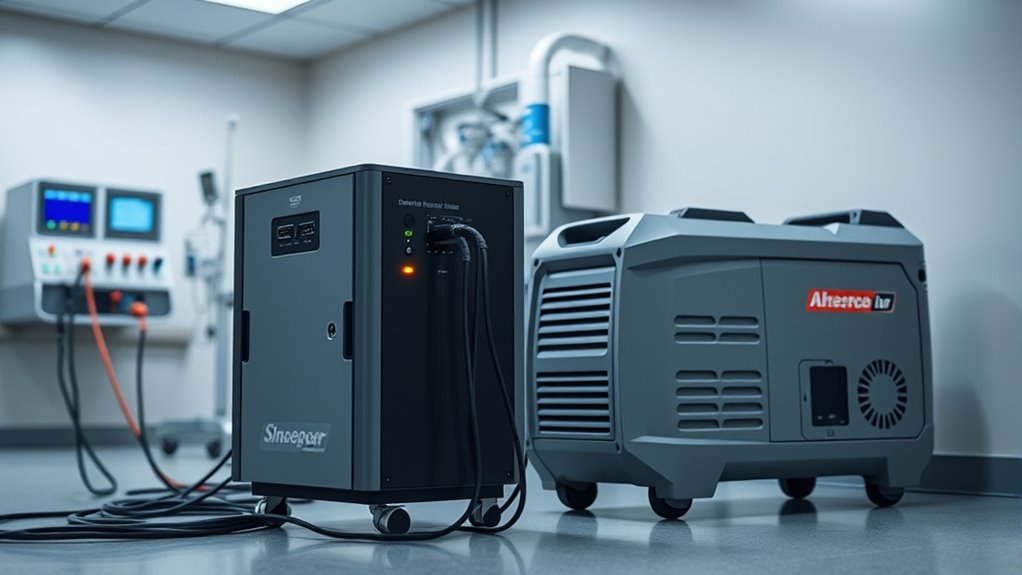
Overcoming space and cost challenges in backup power installation requires innovative approaches that balance limited resources with essential safety needs. You can prioritize critical systems to optimize budget use and consider financing options or tax incentives to reduce upfront costs. Compact solutions like medical-grade UPS units save space while providing reliable power, and portable stations add flexibility but with capacity limits. Modifying existing electrical rooms or re-purposing areas can be complex but necessary. Here’s a quick comparison:
| Solution | Pros | Cons |
|---|---|---|
| Medical-grade UPS | Space-efficient, immediate backup | Limited runtime |
| Portable power stations | Flexible, mobile backup | Limited capacity, runtime |
| Backup generators | Extended backup, high capacity | Space needs, maintenance |
| Modular systems | Scalable, adaptable | Higher initial cost |
| Renewable + batteries | Cost-effective, space-saving | Installation complexity |
This approach helps you balance space, costs, and safety efficiently.
Strategies for Rapid Response and System Integration During Power Outages
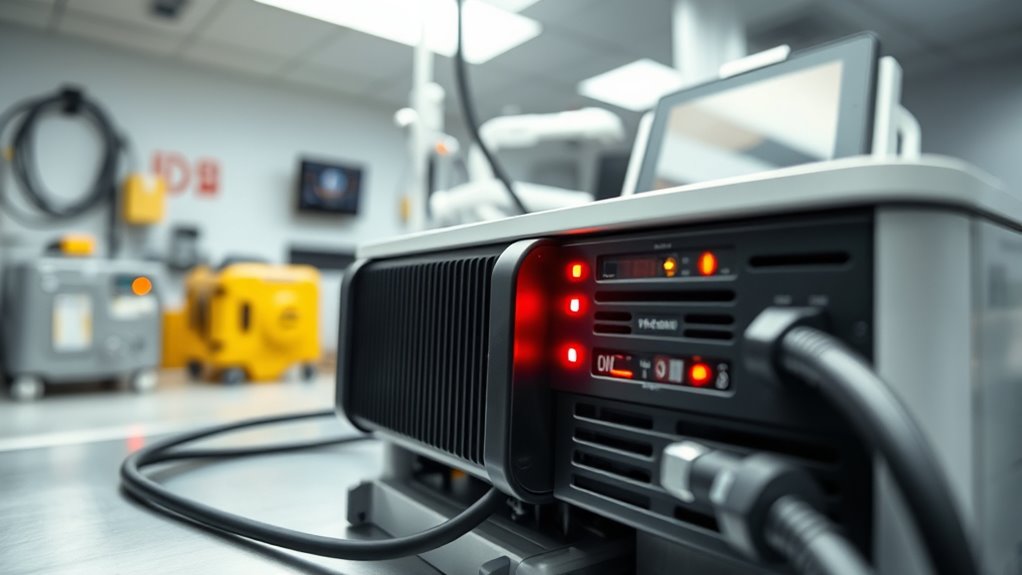
When a power outage occurs, rapid response and seamless system integration are essential to guaranteeing continuous operation of critical medical devices. You need to rely on automated systems that detect outages instantly and switch power sources without delay. Transfer switches enable quick, automated switchover from utility to backup power, minimizing downtime. Line-interactive UPS systems stabilize voltage and maintain power quality, protecting sensitive equipment. Incorporating diagnostics and remote monitoring ensures you receive real-time alerts, allowing swift action. Quick-start propane generators activate faster than diesel, restoring full load capacity rapidly. Additionally, integrating smart energy management systems helps prioritize critical loads, optimize resource use, and prevent overloads during extended outages. This coordinated approach guarantees that vital medical devices stay powered and operational at all times.
Implementing Best Practices for Maintenance and Monitoring of Backup Power

Effective maintenance and monitoring of backup power systems are essential to guarantee they perform reliably during outages. Regular battery checks, thermal scans, and load testing help identify weaknesses early, preventing failures. Follow a structured replacement schedule based on manufacturer guidelines to avoid unexpected power loss. Conduct scheduled inspections of internal components, firmware updates, and testing standards like NFPA 110 to ensure system integrity. Implement real-time monitoring for voltage, battery health, and load conditions, with alerts for faults or anomalies. Use thorough testing—such as generator startup and transfer switch checks—to confirm performance. Keep detailed logs to track trends and predict future needs. Here’s a quick overview:
| Maintenance Area | Key Actions | Frequency |
|---|---|---|
| Battery Maintenance | Voltage checks, thermal scans | Monthly |
| System Inspections | Component, wiring, cooling checks | Quarterly |
| Firmware Updates | Software upgrades | Annually |
| Load Testing | Simulate outages, runtime tests | Biannual |
| Monitoring & Alerts | Real-time system monitoring | Continuous |
Leveraging Advanced Technologies for Enhanced Power Security in Healthcare

Advanced technologies are transforming how healthcare facilities secure and manage power for critical medical devices. You can now leverage high-performance power supplies that meet strict safety standards like EN60601-1, ensuring reliable operation. Multi-output units give you flexible voltage options tailored to diverse device needs, enhancing precision. Digitally configurable AC-DC power supplies offer energy-efficient, compact solutions for imaging, ultrasound, and pumps. Remote monitoring interfaces like I2C and PMBus enable real-time tracking of voltage, current, and temperature, helping you maintain continuous stability. Power supplies designed for applications such as electrosurgery and laser devices focus on reliability and low ripple.
- Real-time remote monitoring and analytics
- Multi-point temperature and hot spot detection
- Integration of intelligent transformer systems
- Cybersecurity protocols safeguarding power software
- Market-driven growth of implantable and wearable power solutions
Frequently Asked Questions
How Often Should Backup Power Systems Be Tested in Hospitals?
You should test backup power systems in hospitals at least monthly, ensuring they operate under load for the required duration. Additionally, conduct weekly inspections to check critical components like fuel, batteries, and cooling systems. NFPA 99 recommends 12 tests annually, spaced between 20 and 40 days apart, with more rigorous testing every 36 months. Regular testing and inspections keep your system reliable and compliant with safety standards.
What Are the Most Cost-Effective Backup Power Options for Small Clinics?
You should consider battery backup systems and mobile power solutions as the most cost-effective options. Battery backups, like line-interactive UPS systems, keep critical equipment running instantly during outages without high upfront costs. Mobile power systems are flexible, portable, and ideal for temporary setups or remote clinics. Both options require minimal infrastructure changes, offer reliable performance, and help maintain patient care without breaking the bank.
How Do Backup Systems Protect Against Power Fluctuations During Normal Operation?
When power fluctuates, backup systems act like guardians, instantly stabilizing voltage and preventing damage. You rely on devices like UPS units and surge protectors that filter spikes and dips, ensuring your medical equipment runs smoothly. These systems automatically switch power sources, avoiding interruptions. Regular maintenance keeps them ready, so during normal operation, they seamlessly protect your critical devices from unexpected surges or dips, maintaining safety and performance effortlessly.
What Are the Key Safety Regulations for Installing Hospital Backup Power?
You must follow key safety regulations when installing hospital backup power, including adhering to NFPA standards like NFPA 70, 99, 101, and 110. Confirm your systems can restore power within required timeframes, with proper sizing and redundancy. Conduct thorough risk assessments, integrate uninterruptible power supplies, and perform regular testing, maintenance, and documentation. These steps guarantee compliance, safety, and reliable support for critical medical devices during outages.
How Can Healthcare Facilities Ensure Compliance With Evolving Backup Power Standards?
You must stay ahead of the game by constantly updating your backup power systems to meet ever-changing standards. Conduct rigorous risk assessments, implement routine testing, and keep meticulous records to demonstrate compliance. Regularly review regulations like NFPA 110, NFPA 99, and local codes, and upgrade your generators and equipment proactively. By doing so, you ensure your facility remains resilient, compliant, and ready to save lives no matter what surprises come your way.
Conclusion
Keeping your critical medical devices powered guarantees patient safety and continuous care. While backup systems might seem costly or complex, investing in reliable UPS solutions and proper maintenance actually saves you money and stress in the long run. Don’t let concerns about installation or costs hold you back—advanced technologies and expert strategies make it easier than ever to secure your healthcare facility’s power supply. Trust in proactive planning to keep your essential equipment always ready.

